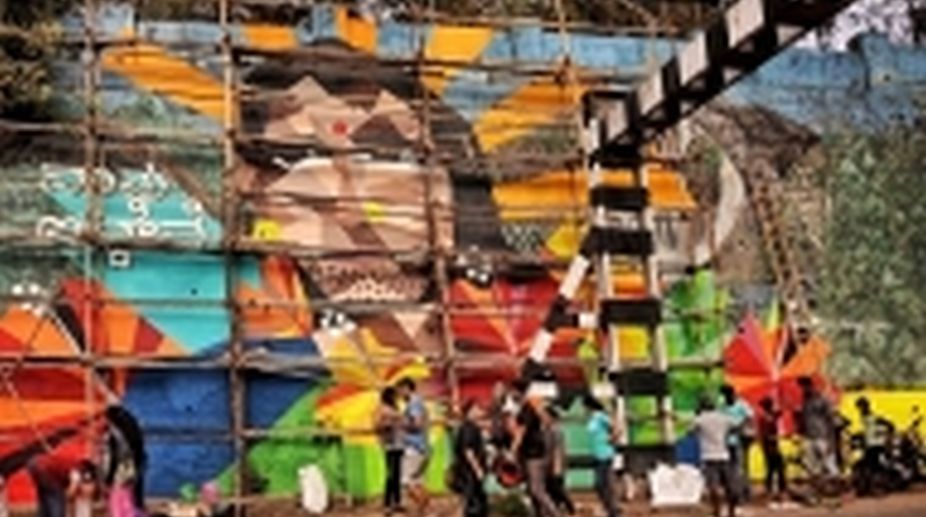There’s no protest, no placards, no shouting of slogans — rather a riot of colours. A group of transgenders has come out on the streets to vent their emotions, demand their rights and show their creative talents to the world through murals.
It’s the outcome of the Chennai-based Aravani Art Project that documentary maker Poornima Sukumar started off as an experiment around two years ago, little realising it would soon turn into a major platform for the transgender community to create a space for themselves in society.
Advertisement
“While working on the documentary, I came across many from the transgender community and felt I should do something or give them a platform to speak up for themselves. I have also been a mural artist; so I… plunged into something I was comfortable with,” Sukumar said.
How did the name come about? Mythology has it that before the start of Mahabharatha war, on the advice of Krishna, the Pandavas decided to make a human sacrifice to ensure their victory.
Aravan, one of the sons of Arjuna — born to princess Chithrangadha — volunteered to be sacrificed. But he first wanted to get married. Krishna takes the form of a woman — Mohini — and marries him. And the next day Aravan offers himself for sacrifice. And, Aravan is one of the gods that transgenders worship.
The project currently functions with four members based in Chennai, Mumbai, Bengaluru and Pune who get the local transgender community involved in making murals. Sukumar pointed out that Aravani Art Project is not just about professional mural artists; instead they believe in creating a friendly working space for anybody who is interested to be a part of the team, which has left its mark on the streets of Bengaluru, Mumbai, Jaipur, Chennai, Pune and even Colombo in Sri Lanka.
Take Shanti, a transgender and an activist from Bengaluru who was working as a radio jockey and going through a rough phase in her life. She was looking for a medium to vent emotions that had been long suppressed. And nothing could have brought more colour into her life than getting involved in the Aravani Art Project which gave her a chance to bring out her artistic aspect on the streets and walls.
“Art and activism can be combined… which I call as artivism. Art can certainly bring changes in people’s perception towards the community. We don’t believe in protests, but silently raising voice against the so long persisting discrimination against us through art. The society can see it and leaves an immediate impact on them. Members of the transgender community are perceived as sex workers or beggars,” Shanti said.
Like Shanti, Shonali has been associated with the project since its inception. For her, it was not just a chance to translate her imagination on the walls but also a mode to convey the need of awareness — first among the transgender community and then in society.
“We wanted to inform and make the community aware of their own capabilities. Unless the transgenders become aware of their potentialities, bringing change in the community won’t be possible. The community needs to know its strengths and perhaps then we can bring a change in our status,” Shonali said.
It was not an easy start for Sukumar when she began the project. Her first challenge was to win the trust of the community and get them involved.
“When I discussed the idea with the transgenders, they laughed at it, didn’t take it seriously; I had to convince them that the project will help them to uplift their status in society,” she recalled.
Even while choosing the theme, she had to ensure the collaboration of the community, especially on the message they wanted to convey, what to write on the walls and how a portrait would look as they even paint faces of transgenders.
“The themes are basically on the issues that the community faces. We also try to highlight the culture of the community because it’s hidden and not many people know about it,” she added.
Choosing the right wall is also an important aspect of the project, as maximum visibility is required.
“The choice of areas or walls are a mixture of experiences. Some we did not have a choice and took up what we got, but mostly we have been lucky to get walls which are close to the places where transgenders reside and make it easier for them to spread awareness,” Sukumar noted.
Both Shanti and Shonali pitched that no matter how progressive the country becomes, people laugh and ridicule at transgenders.
“And this is something that is difficult to overturn. Even though the transgender bill (on protecting their rights) has been implemented, acceptance is low in India. Education and healthcare are important to the community, but these are excluded,” Shanti lamented.
“Art can bring change. Whenever people look at it, they will at least think about the crisis that we face in our lives and might change their perspective towards us,” Shonali said.











